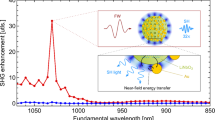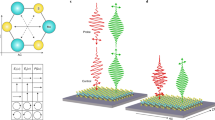Abstract
THE phenomenon of second-harmonic generation (SHG), whereby a material under illumination generates light at twice the incident frequency, is finding increasing use in optical signal processing. The principal requirement for SHG is a non-centrosymmetric structure; in organic materials, this can be achieved through the use of Langmuir–Blodgett films, which offer control of structure at the molecular level. SHG has been demonstrated in films composed of hemicyanine dyes of the general formula D—C6H4— CH=CH—C5H4N+— RX-, where D is an electron donor, R is usually a hydrophobic alkyl chain and X- is a counterion such as Br- or I-. The frequency-doubling properties of these films are sensitive to the choice of donor group1,2 the extent of molecular aggregation3,4and the type of packing5–7 Mixed films, in which the dye molecules are interspersed with an inert phase, have been used to reduce aggregation and consequently enhance SHG3,8, but these films have the potential disadvantage of phase separation. Here we show that the use of an amphiphilic anion as both counterion and spacer molecule gives rise to an ordered segregation of the hemicyanine chromophores, and greatly enhanced SHG.
This is a preview of subscription content, access via your institution
Access options
Subscribe to this journal
Receive 51 print issues and online access
$199.00 per year
only $3.90 per issue
Buy this article
- Purchase on Springer Link
- Instant access to full article PDF
Prices may be subject to local taxes which are calculated during checkout
Similar content being viewed by others
References
Lupo, D. et al. J. opt. Soc. Am. B5, 300–308 (1988).
Bubeck, C. et al. Angew. Chem. Int. Edn Engl. 3, 54–58 (1991).
Schildkraut, J. S., Penner, T. L., Willand, C. S. & Ulman, A. Opt. Lett. 13, 134–136 (1988)
Steinhoff, R., Chi, L. F., Marowsky, G. & Möbius, D. J. opt. Soc. Am. B6, 843–847 (1989).
Ashwell, G. J., Dawnay, E. J. C., Kuczynski, A. P. & Martin, P. J. SPIE Int. Soc. opt. Engng 1361, 589–598 (1991).
Ashwell, G. J. et al. Mat. Res. Soc. Symp. Proc. 247, 787–792 (1992).
Anderson, B. L. et al. Thin Solid Films 179, 413–421 (1989).
Girling, I. R. et al. J. opt. Soc. Am. B4, 950–955 (1987).
Girling, I. R. et al. Thin Solid Films 132, 101–112 (1985).
Cross, G. H. et al. Thin Solid Films 156, 39–52 (1988).
Young, M. C. et al. Thin Solid Films 182, 319–332 (1989).
Kowel, S. T., Hayden, L. M. & Selfridge, R. H. SPIE Int. Soc. opt. Engng 682, 103–108 (1986).
Hayden, L. M. et al. Thin Solid Films 160, 379–388 (1988).
Selfridge, R. H. et al. Thin Solid Films 160, 471–476 (1988).
Stroeve, P., Saperstein, D. D. & Rabolt, J. F. Thin Solid Films 179, 529–534 (1989).
Stroeve, P., Saperstein, D. D. & Rabolt, J. F. J. Chem. Phys. 92, 6958–6967 (1990).
Ancelin, H. et al. Langmuir 6, 172–177 (1990).
Shirota, K., Kajikawa, K., Takezoe, H. & Fukuda, A. Jap. J. appl. Phys. 29, 750–755 (1990).
Kajikawa, K., Shirota, K., Takezoe, H. & Fukuda, A. Jap. J. appl. Phys. 29, 913–917 (1990).
Kajikawa, K., Kigata, K., Takezoe, H. & Fukuda, A. Molec. Cryst. liq. Cryst. A182, 91–101 (1990).
Author information
Authors and Affiliations
Rights and permissions
About this article
Cite this article
Ashwell, G., Hargreaves, R., Baldwin, C. et al. Improved second-harmonic generation from Langmuir–Blodgett films of hemicyanine dyes. Nature 357, 393–395 (1992). https://doi.org/10.1038/357393a0
Received:
Accepted:
Issue Date:
DOI: https://doi.org/10.1038/357393a0
This article is cited by
-
Studies on Size Dependent Structures and Optical Properties of CdSeS Clusters
Journal of Cluster Science (2020)
-
Sub-wavelength modulation of χ(2) optical nonlinearity in organic thin films
Nature Communications (2017)
-
Enhanced Second Harmonic Generation by Mode Matching in Gain-assisted Double-plasmonic Resonance Nanostructure
Scientific Reports (2017)
-
Phase transition of lipid-like monolayer characterized by second harmonic generation
Science in China Series B: Chemistry (1999)
Comments
By submitting a comment you agree to abide by our Terms and Community Guidelines. If you find something abusive or that does not comply with our terms or guidelines please flag it as inappropriate.



